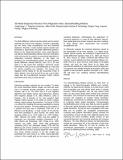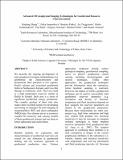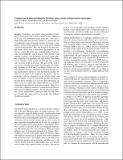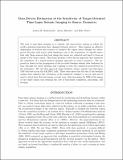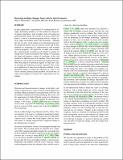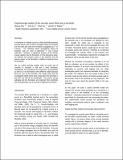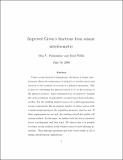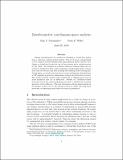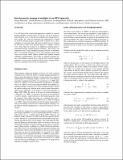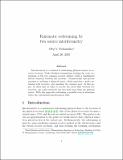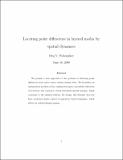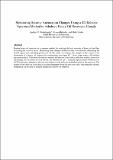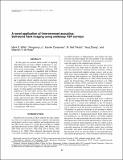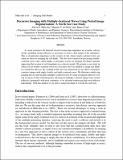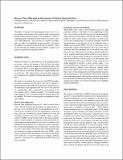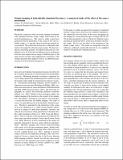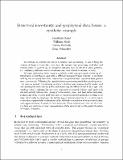Browsing Earth Resources Laboratory by Subject "Imaging"
Now showing items 1-20 of 23
-
3D Weak-Dispersion Reverse-Time Migration with a StereoModeling Method
(Massachusetts Institute of Technology. Earth Resources Laboratory, 2013)The finite difference method has been widely used in seismic modeling and reverse time migration. However, it generally has two issues: large computational cost and numerical dispersion. Recently, a nearly-analytic discrete ... -
Advanced 3D Geophysical Imaging Technologies for Geothermal Resource Characterization
(Massachusetts Institute of Technology. Earth Resources Laboratory, 2012)We describe the ongoing development of joint geophysical imaging methodologies for geothermal site characterization and demonstrate their potential in two regions: Krafla volcano and associated geothermal fields in ... -
Comparison of microearthquake locations using seismic interferometry principles
(Massachusetts Institute of Technology. Earth Resources Laboratory, 2012)Mapping, localization, and general characterization of problems in reservoir fracture systems is one of the most important in oil, gas, and geothermal energy production. One way to study and monitor these fracture systems ... -
Data-Driven Estimation of the Sensitivity of Target-Oriented Time-Lapse Seismic Imaging to Source Geometry
(Massachusetts Institute of Technology. Earth Resources Laboratory, 2012)The goal of time-lapse imaging is to identify and characterize regions in which the earth's material properties have changed between surveys. This requires an effective deployment of sources and receivers to monitor the ... -
Detecting medium changes from coda by interferometry
(Massachusetts Institute of Technology. Earth Resources Laboratory, 2010)In many applications, sequestering CO[subscript 2] underground for example, determining whether or not the medium has changed is of primary importance, with secondary goals of locating and quantifying that change. We ... -
Experimental studies of the acoustic wave field near a borehole
(Massachusetts Institute of Technology. Earth Resources Laboratory, 2013)A monopole or a dipole source in a fluid borehole generates acoustic waves, part of which propagate along the borehole and the other part enter the formation propagating as P- or S-waves. The refracted waves propagating ... -
Imaging Salt Dome Flank and Dipping Sediments Using Time Reversed Acoustics
(Massachusetts Institute of Technology. Earth Resources Laboratory, 2006)In this paper we define the theory and basic principles to move (redatum) the surface shots from a walk away VSP to be as if they had been located in the borehole. We will refer to this theory using several of the terms ... -
Improved Green’s functions from seismic interferometry
(Massachusetts Institute of Technology. Earth Resources Laboratory, 2008-06-16)Under certain theoretical assumptions, the theory of seismic interferometry allows the construction of artificial (or virtual) sources and receivers at the locations of receivers in a physical experiment. This is done ... -
Interferometric correlogram-space analysis
(Massachusetts Institute of Technology. Earth Resources Laboratory, 2009-05-31)Seismic interferometry is a method of obtaining a virtual shot gather from a collection of actual shot gathers. The set of traces corresponding to multiple actual shots recorded at two receivers is used to synthesize a ... -
Interferometric correlogram-space analysis
(Massachusetts Institute of Technology. Earth Resources Laboratory, 2010-04-26)Seismic interferometry is a method of obtaining a virtual shot gather from a collection of physical shot gathers. The set of traces corresponding to two common receiver gathers from many physical shots is used to synthesize ... -
Interferometric imaging of multiples in an RTM approach
(Massachusetts Institute of Technology. Earth Resources Laboratory, 2010)It is well known that reverse-time migration is capable of correctly imaging multiply scattered energy. To do this, one of the interfaces from which the waves scatter must be included in the background velocity model. ... -
Kinematic redatuming by two source interferometry
(Massachusetts Institute of Technology. Earth Resources Laboratory, 2010-04-26)Interferometry is a method of redatuming physical sources to receiver locations. Under idealized assumptions stacking the cross correlogram of the two common receiver gathers yields a bandlimited Green's function between ... -
Locating point diffractors in layered media by spatial dynamics
(Massachusetts Institute of Technology. Earth Resources Laboratory, 2008-06-16)We present a new approach to the problem of detecting point diffractors from active source surface seismic data. We formulate an optimization problem in the configuration space of possible collections of scatterers and ... -
Monitoring Seismic Attenuation Changes Using a 4D Relative Spectrum Method in Athabsca Heavy Oil Reservoir, Canada
(Massachusetts Institute of Technology. Earth Resources Laboratory, 2012)Heating heavy oil reservoirs is a common method for reducing the high viscosity of heavy oil and thus increasing the recovery factor. Monitoring these changes in the reservoir is essential for delineating the heated region ... -
A Novel Application of Time Reversed Acoustics: Salt Dome Flank Imaging Using Walkaway VSP surveys
(Massachusetts Institute of Technology. Earth Resources Laboratory, 2006-03-01)In this paper we present initial results of applying Time-Reversed Acoustics (TRA) technology to saltdome flank, seismic imaging. We created a set of synthetic traces representing a multilevel, walkaway VSP for a model ... -
Recursive Imaging with Multiply-Scattered Waves Using Partial Image Regularization: A North Sea Case Study
(Massachusetts Institute of Technology. Earth Resources Laboratory, 2010)As more resources are directed toward reverse-time migration an accurate velocity model, including strong reflectors, is necessary to form a clear image of the subsurface. This is of particular importance in the vicinity ... -
Reverse Time Migration in the presence of known sharp interfaces
(Massachusetts Institute of Technology. Earth Resources Laboratory, 2013)We propose using the forward propagated source wave to create synthetic receiver data on the surfaces of the computational domain where real receiver data is not available as a means of exploiting known information about ... -
Scholte waves generated by seafloor topography
(Massachusetts Institute of Technology. Earth Resources Laboratory, 2012)Seafloor topography can excite strong interface waves called Scholte waves that are often dispersive and characterized by slow propagation but large amplitude. This type of wave can be used to invert for near seafloor shear ... -
Seismic imaging of hydraullically-stimulated fractures: A numerical study of the effect of the source mechanism
(Massachusetts Institute of Technology. Earth Resources Laboratory, 2012)We present a numerical study of seismic imaging of hydraulically stimulated fractures using a single source from an adjacent fracturing-process. The source is either a point force generated from the perforation of the ... -
Structural uncertainty and geophysical data fusion: A synthetic example
(Massachusetts Institute of Technology. Earth Resources Laboratory, 2003)We attempt to address two issues in seismic data processing: 1) quantifying the various forms of error that enter into the seismic data processing work-flow and relating them to uncertainty on imaged structures; and, 2) ...

